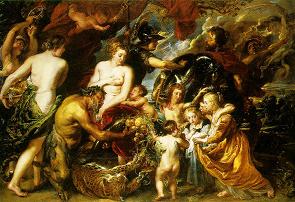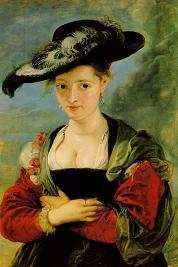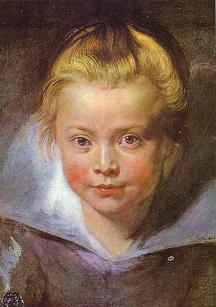10-4-2004
PETER
PAUL RUBENS
(1577 -
1640)
The one northern
artist to come most directly into contact with the Roman atmosphere Of
Carracci’s and Caravaggio's days was a generation older than Poussin and Claude,
and about as old as Guido Reni. He I was the Fleming Peter Paul Rubens
(1577-1640), who came to Rome in 1600 when he was twenty-three years old -
perhaps the most impressionable age. He must have listened to many heated
discussions on art, and studied a great number of new and older works, not only
in Rome, but also in Genoa and Mantua (where he stayed for some time). He
listened and learned with keen interest, but does not seem to have joined any of
the 'movements' or groups. In his heart he remained a Flemish artist -an artist
from the country where Van Eyck and Rogier van der Weyden and Bruegel had
worked. These painters from the Netherlands had always been most interested in
the variegated surfaces of things: they had tried to use all artistic means
known to them to express the texture of cloth and living flesh, in short to
paint as faithfully as possible everything the eye could see. They had not
troubled about the standards of beauty so sacred to their Italian colleagues,
and they had not even always shown much concern for dignified subjects. It was
in this tradition that Rubens had grown up, and all his admiration for the new
art that was developing in Italy does not seem to have shaken his fundamental
belief that a painter's business was to paint the world around him; to paint
what he liked, to make us feel that he enjoyed the manifold living beauty of
things. To such an approach there was nothing contradictory in Caravaggio's and
Carracci's art. Rubens admired the way in which Carracci and his school revived
the painting of classical stories and myths and arranged impressive altar-panels
for the edification of the faithful; but he also admired the uncompromising
sincerity with which Caravaggio studied nature.
When Rubens returned to Antwerp in 1608 he was a man of thirty-one, who had
learned everything there was to be learned; he had acquired such facility in
handling brush and paint, in representing nudes and drapery, armour and jewels,
animals and landscapes, that he had no rival north of the Alps. His predecessors
in Flanders had mostly painted on a small scale. He had brought from Italy the
predilection for huge canvases to decorate churches and palaces, and this suited
the taste of the dignitaries and princes. He had learned the art of arranging
the figures on a vast scale, and of using light and colours to increase the
general effect.
|
Fígure 1,
a sketch for the painting over the high altar of an Antwerp church, shows how
well he had studied his Italian predecessors, and how boldly he developed their
ideas. It is again the old, time-honoured theme of the Holy Virgin surrounded by
saints, with which artists had grappled at the time of the Wilton Diptych,
Bellini's 'Madonna', or Titian's 'Pesaro Madonna', and it may be worth while to
turn to these illustrations to see the freedom and ease with which Rubens
handled the ancient task. One thing is clear at the first glance: there is more
movement, more light, more space, and there are more figures in this painting
than in any of the earlier ones. The saints are crowding to the lofty throne of
the Virgin in a festive throng. In the foreground the Bishop St Augustine, the
Martyr St Lawrence with the grill on which he suffered, and the monk St Nicholas
of Tolentino lead the spectator on to their object of worship. St George with
the Dragon, and St Sebastian with a quiver and arrows, look into each
other's eyes in fervent emotion, while a warrior -the palm of martyrdom in
his hand- is about to kneel before the throne. A group of women, among them
a nun, are looking up enraptured to the main scene, |
|
Fig. 1
Click to enlarge
Virgin and Child enthroned with saints
c. 1627-8
Sketch for a large altar painting; Oil on wood
80.2 x 55.5 cm
Gemäldegalerie, Staatliche
Museen, Berlin |
|
in which a young girl, assisted by a
little angel, is falling on her knees to receive a ring from the little Christ
Child, who is bending towards her from His mother's lap. It is the legend of the
betrothal of St. Catherine, who saw such a scene in a vision and considered
herself the Bride of Christ. St. Joseph watches benevolently from behind the
throne, and St Peter and St Paul - one recognizable by the key, the other by the
sword - stand in deep contemplation. They make an effective contrast to the
imposing figure of St. John on the other side, standing alone, bathed in light,
throwing up his arms in ecstatic admiration while two charming little angels
drag his reluctant lamb up the steps of the throne. From the sky another pair of
little angels come rushing down to hold a wreath of laurels over the Virgin's
head.
| |
Fig. 2
Head of a
child, probably the artist’s daughter Clara Serena, c. 1616
Oil on
canvas, mounte don wood,
33 x 26,3 cm
Sammlungen
des Fürsten von Liechtenstein, Vaduz |
Having looked at the details, we must once more consider the whole, and admire
the grand sweep with which Rubens has contrived to hold all the figures
together, and to impart to it all an atmosphere of joyful and restive solemnity.
Small wonder that a master who could plan such vast pictures with such sureness
of hand and eye soon had more orders for paintings than he could cope with
alone. But this did not worry him. Rubens was a man of great organizing ability
and great personal charm; many gifted painters in Flanders were proud to work
under his direction and thereby to learn from him. If an order for a new picture
came from one of the churches, or from one of the kings or princes of Europe, he
would sometimes paint only a small coloured sketch. (Fígure 1 is such a
coloured sketch for a large composition.) It would be the task of is pupils or
assistants to transfer these ideas on to the large canvas, and only when they
had finished grounding and painting according to the rnaster's ideas might he
take the brush again and touch up a face here and a silken dress there, or
smooth out any harsh contrasts. He was confident that his brushwork could
quickly impart life to anything, and he was right. |
|
|
For that was the greatest
secret of Rubens's art- his magic skill in making anything alive, intensely and
joyfully alive. We can best gauge and admire this mastery of his in some of the
simple drawings and paintings done for his own pleasure. Figure 2 shows
the head of a little girl; probably Rubens's daughter. There are no tricks of
composition here, no splendid robes or streams of light, but a simple en face
portrait of a child. And yet it seems to breathe and palpitate like living
flesh. Compared with this, the portraits of earlier centuries seem somehow
remote and unreal - however great they may be as works of art. It is vain to try
to analyse how Rubens achieved this impression of gay vitality, but it surely
had something to do with the bold and delicate touches of light with which he
indicated the moisture of the lips and the modelling of the face and hair. |
|
|
|
 |
Fig. 3
Click to enlarge
Allegory on the blessings of peace
1629-30
Oil on canvas
203.5 x 298 cm
National Gallery, London
To an even greater degree than Titian before him, he used the brush as his
main instrument. His paintings are no longer drawings carefully modelled in
colour - they are produced by ‘painterly' means, and that enhances the
impression of life and vigour.
It was a combination of his unrivalled gifts in arranging large colourful
compositions, and in infusing them with buoyant energy, that secured a fame and
success for Rubens such as no painter had enjoyed before. His art was so
eminently suitable to enhance the pomp and splendour of palaces and to glorify
the powers of this world, that he enjoyed something like a monopoly in the
sphere in which he moved. It was the time during which the religious and social
tensions of Europe carne to a head in the fearful Thirty Years' War on the
Continent and in the Civil War in England. On the one side stood the absolute
monarchs and their courts, most of them supported by the Catholic Church - on
the other the rising merchant cities, most of them Protestant. The Netherlands
themselves were divided into Protestant Holland, which resisted Spanish
Catholic' domination, and Catholic Flanders, ruled from Antwerp under Spanish
allegiance. It was as the painter of the Catholic camp that Rubens rose to his
unique position. He accepted commissions from the Jesuits in Antwerp and from
the Catholic rulers of Flanders, from King Louis XIII of France and his crafty
mother Maria de' Medici, from King Philip III of Spain and King Charles I of
England, who conferred a knighthood on him. When travelling from court to court
as an honoured guest, he was often charged with delicate political and
diplomatic missions, foremost among them that of effecting a reconciliation
between England and Spain in the interest of what we would call today a
'reactionary' bloc. Meanwhile he remained in touch with the scholars of his age,
and engaged in learned Latin correspondence on questions of archaeology and art.
His self-portrait with the nobleman's sword, shows that he was very
conscious of his unique position. Yet there is nothing pompous or vain in the
shrewd look of his eyes. He remained a true artist. All the while, pictures of
dazzling mastery poured out from his Antwerp studios on a stupendous scale.
Under his hand, the classical fables and allegorical inventions became as
convincingly alive as the picture of his own daughter.
Allegorical pictures are usually regarded as rather boring and abstract, but for
the age of Rubens they were a convenient means of expressing ideas. Figure 3
is such a picture, which Rubens is said to have presented as a gift to Charles
I, when he tried to induce him to make peace with Spain. The painting contrasts
the blessings of peace with the horrors of war. Minerva, the goddess of wisdom
and the civilizing arts, drives away Mars, who is about to withdraw his dreadful
companion, the Fury of war, having already turned back. And under the protection
of Minerva the joys of peace are spread out before our eyes, symbols of
fruitfulness and plenty as only Rubens could conceive them: Peace offering her
breast to a child, a faun
| |
|
|
blissfully eyeing the gorgeous fruits, figure 4, the other companions
of Bacchus dancing maenads with gold and treasures and the panther playing
peacefully like a big cat; on the other sidle three children with anxious
eyes, fleeing from the terror of war to the haven of peace and plenty,
crowned by a young genius. No one who loses himself in the rich details of
this picture, with its vivid contrasts and glowing colours, can fail to see
that these ideas were to Rubens not pale abstractions but forceful
realities. Perhaps it is because of this quality that some people must first
get accustomed to Rubens before they begin to love and understand him. He
had no use for the 'ideal' forms of classical beauty. They were too remote
and abstract for him. His men and women are living beings such as he saw and
liked. And so, since slenderness was not the fashion in the Flanders of his
day, some people object to the 'fat women' in his pictures. This criticism,
of |
course, has little to do
with art and we need not, therefore, take it too seriously. But, since it is so
often made, it may be well to realize that joy in exuberant and almost
boisterous life in all its manifestations saved Rubens from becoming a mere
virtuoso of his art. It turned his paintings from mere Baroque decorations of
festive halls into master pieces which retain their vitality even within the
chilling atmosphere of museums.
(E.H. Gombrich, The Story of Art.
Phaidon, London, 1995, Reprinted 1999).
| |
|
Click to enlarge
The Union of Earth and Water
c. 1618
Oil on canvas
222.5 x 180.5 cm
Hermitage, St. Petersburg |
|
| |
Click to enlarge
The Rape of the Daughters of Leucippus
c. 1618
Oil on canvas
224 x 210.5 cm
Alte Pinakothek, Munich |
|
|
| |
|
Click to enlarge
Bathseba, 1635 (fragment)
(Die Alte Meisters Gallerie, Dresden) |
|
|
|
|
 |
Click to enlarge
Portrait of Susanna Fourment
("Le chapeau de paille")
c. 1622-25
Oil on panel
79 x 54 cm
National Gallery, London

